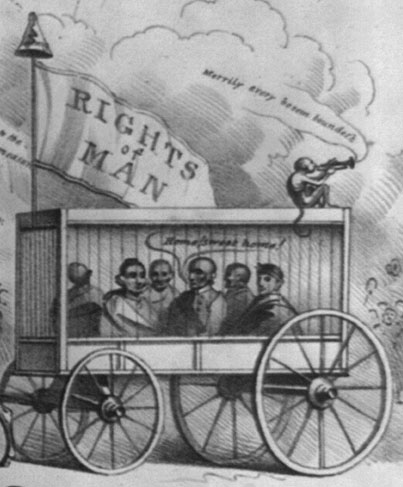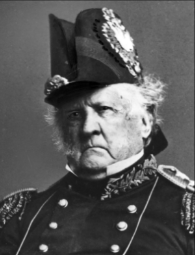
A political cartoon of Native Americans being transported. Source: Digital History
¨Andrew Jackson was responsible for putting Indian removal policies in place; however, he left office before the 1838 deadline for the Cherokees to surrender their lands in the East. It was Jackson’s presidential successor, Martin Van Buren, who ordered General Winfield Scott to forcibly evict the Cherokees. Scott’s troops rounded up thousands of Cherokees and then imprisoned them in forts in Georgia, Tennessee, North Carolina and Alabama. During these roundups, the Indians weren’t given time to pack and family members, including children, sometimes got left behind if they weren’t home when the soldiers showed up. The Indians were transferred from the forts to detention camps, most of them in Tennessee, to await deportation. At both the forts and camps, living conditions were bleak and diseases rampant, and an unknown number of Cherokees died.¨ (Nix)
“The Cherokee were given two years to migrate voluntarily, at the end of which time they would be forcibly removed. By 1838 only 2,000 had migrated; 16,000 remained on their land. The U.S. government sent in 7,000 troops, who forced the Cherokees into stockades at bayonet point. They were not allowed time to gather their belongings, and as they left, whites looted their homes. Then began the march known as the Trail of Tears, in which 4,000 Cherokee people died of cold, hunger, and disease on their way to the western lands”. (PBS)

A political cartoon of Native Americans being transported. Source: Digital History
Inside the cage a forlorn Indian sings "Home! Sweet home!" The image depicts Jackson's controversial Indian resettlement program, whereby thousands of Cherokees, Seminoles and other natives of the eastern United States were uprooted and moved to less desirable lands farther West.

A photo of General Windfield Scott. Source: Mintz, S., & McNeil, S.
General Winfield Scott: ¨Chiefs, head-men and warriors! Will you then, by resistance, compel us to resort to arms? God forbid! Or will you, by flight, seek to hide yourselves in mountains and forests, and thus oblige us to hunt you down? Remember that, in pursuit, it may be impossible to avoid conflicts. The blood of the white man or the blood of the red man may be spilt, and, if spilt, however accidentally, it may be impossible for the discreet and humane among you, or among us, to prevent a general war and carnage. Think of this, my Cherokee brethren! I am an old warrior, and have been present at many scenes of slaughter, but spare me, I beseech you, the horror of witnessing the destruction of the Cherokees.” (Mintz, S., & McNeil, S.)